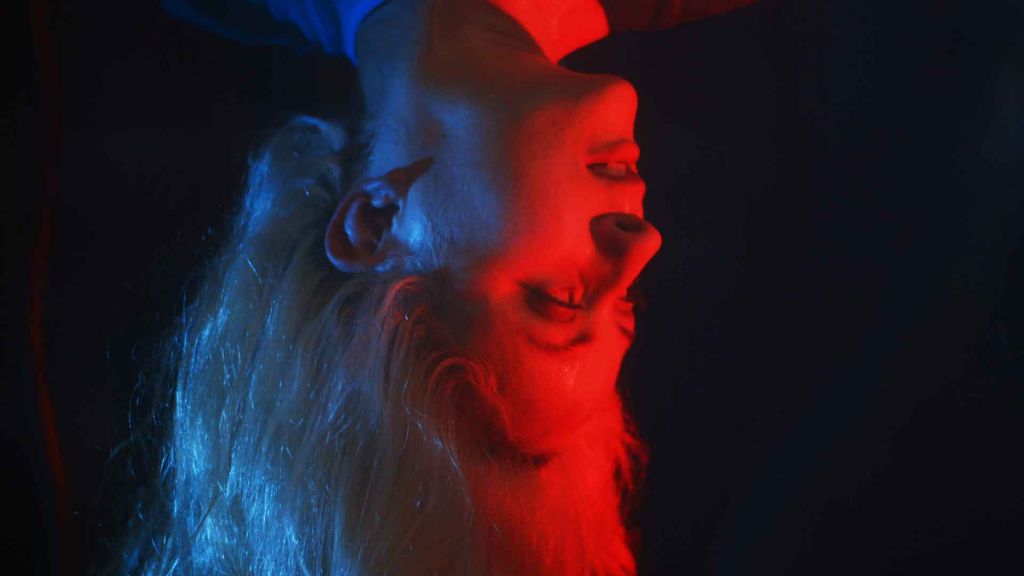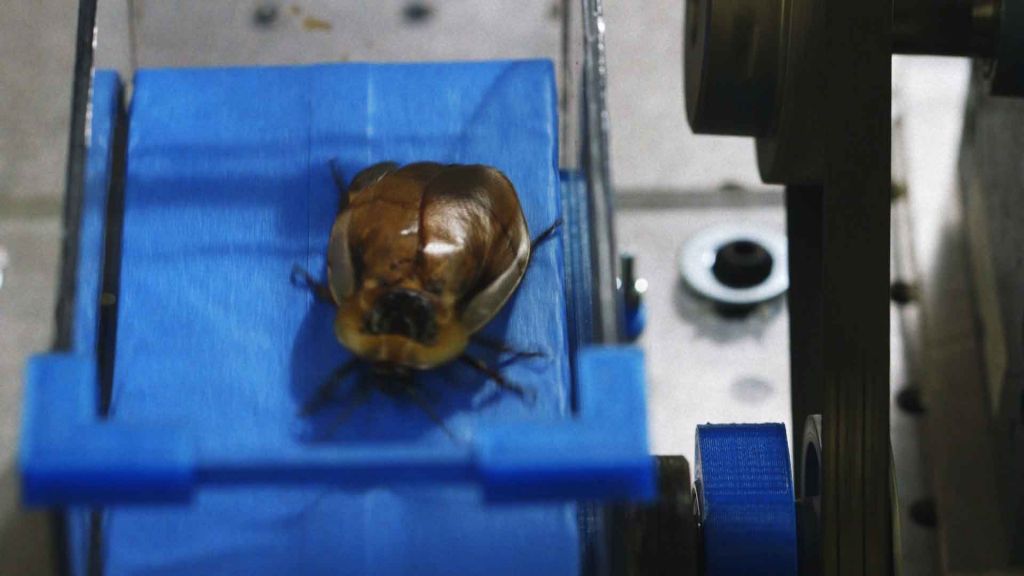Words by Eleanor Wakeford

You and I, who are looking ahead to the future monster. We talk about synthetic reproduction. You say that it shouldn’t be called reproduction but synthetic production—the fabrication of an entirely new species. … What would happen if it was one of your spermatozoids infected with AIDS that contained the gene of the future savior of the planet? [1]
— Paul B. Preciado
In my previous article, I looked at the way in which the female body and its associations with liquidity becomes a contagious force in Marianna Simnett’s video installation Blood in My Milk (2018). In contrast to the supposedly bounded, self-contained body of the white, male ‘self’ of western discourse, the ‘leaky’ female body has connotations of ‘contagion and disorder’: ‘a formless flow … a formlessness that engulfs all form, a disorder that threatens all order’. [2] Throughout the interweaving narratives of Blood in My Milk, Simnett harnesses the subversive power of the female body to infect the bodies and minds of her audience: ‘to shake your status quo, to shatter a unified sense of self’. [3]
As the upheaval of Covid-19 reveals stark societal disparities and riots spread globally in response to racially-motivated violence, Simnett’s work suggests that contagion itself provides an essential lens to radically reassess systems, processes and societies that depend on strict, and unequal, divisions between self and other.
Michel Foucault argued that power depends on the creation and reproduction of static subjectivities to manage both individual bodies and wider populations. Individual identity, he claimed, is a product of power that creates ‘docile’ and predictable bodies through a process of normalization: ‘each individual … subjects to [the norm] his body, his gestures, his behaviour, his aptitudes, his achievements’. [4]
In Testo Junkie, Preciado states that these ‘somatic fictions’ are now reproduced in the material composition of the body itself, highlighting as an example the synthetic hormones in the contraceptive pill that supplement, reinforce and reproduce gender narratives. [5]
Preciado, however, attempts to infect these processes; Testo Junkie documents Preciado’s illegal experimentation with a testosterone supplement as a, at the time, cis-female. He claims that becoming a ‘political subject’ begins ‘by being a lab rat in her or his own laboratory’. [6] His own self-experimentation is an attempt to circumvent systems that, in the words of Simnett, attempt to ‘box people into categories of male, female, sick, broken, ugly, hysterical’. [7]
Throughout Blood in My Milk, the operating theatre is depicted as a site of identity construction and maintenance. In Blood, the work’s second chapter, the operation to remove Isabel’s turbinate bones is depicted as an attempt to remove the misbehaving ‘other’ from Isabel’s body and maintain a secure sense of self; ‘don’t worry’, the surgeon tells Isabel, ‘you’ll be better off without them’. [8]
While Isabel sings that she’d ‘rather be alone, I don’t want my turbinate bones’, the bones continue to haunt her, challenging her assumptions of independent and integral identity; as Filipa Ramos asks, ‘what is “me” if not the sum of all the parts of this body that I call “mine”’? [9]
At the end of the narrative, blood gushes from Isabel’s nose as a refusal of this division between self and other, an ‘uncontrollable flow’ that transgresses borders and refuses systems that attempt to contain, categorise, and control bodies. [10] Against attempts to reinforce the borders of the individual ‘self’, in the world of Simnett’s surreal fairy tales, blood is depicted as a radical method of ‘making kin’, even with potentially mortal enemies. [11]
In the original standalone film of Blood, Isabel’s turbinate bones are told off for ‘fighting [their] own flesh and blood’ by Lali, an Albanian sworn virgin (burrnesha). The tradition of the sworn virgins emerged from the patriarchal law of the Kanun; if a family has no male heir or loses a son to a blood feud, a daughter can be chosen to live as a sworn virgin, living as a male and treated accordingly.
During Isabel’s stay with Lali, she is in Lali’s besa, meaning she is protected. Besa is the highest authority in the Kanun; meaning to offer your loyalty, a promise, or to provide protection. Besa is integral in forming alliances, yet implicit in besa is blood; if the code of besa is broken, it results in a blood feud: ‘two lives for one’. [12] Besa and blood link unlikely bodies, allies and enemies, in which lives become intimately connected with and dependent on others: ‘the continual debt of one for one’. [13]
The blood feud resonates with Levi-Strauss’s writing on pre-modern ‘anthropophagic’ societies: ‘They eat their enemies, while we vomit ours. [14] Yet this notion of imbibing or incorporating the ‘other’ suggests a radical notion of making kin that ‘cuts across the frontiers of hostile groups’. [15]
In Blood in My Milk, the explicit violence of making kin – through the blood feud or cannibalism – is held up against the more implicit violence of the operating theatre and its role in maintaining divisions between self and other. In the subsequent chapter, Blue Roses, Simnett interweaves footage from a workshop creating cyborg cockroaches with a depiction of an operation removing varicose veins from a disembodied leg.
While the workshop participants turn the cockroaches into cyborgs, controlling their movements through electric shocks to their legs, Simnett suggests that similar mechanisms of control are being enacted through the procedure: like the cockroaches, the patient is ‘learning to behave’.
The reassuring platitudes of the surgeon hint at the violence of the procedure: ‘If we just rip your veins out, they’ll just grow back again’. Yet, like the cockroaches that we are told cannot feel pain, the patient is rendered voiceless, unable to express the pain of the procedure: ‘a pop, then a crack, but none of my words made a sound’. The leg, however, no longer ‘docile’, enacts its own form of rebellion; it mutates, bursting with blood until it violently explodes.
In Blue Roses, blood appears again as a refusal of containment and control; like Isabel’s turbinate bones, the veins continue to haunt Simnett’s protagonist, who laments that ‘they keep returning … they won’t go away’. Yet this bloody explosion is also another expression of violently making kin.
As the narrative moves to the inside of the vein itself, Simnett articulates a new relationship with the parasitic, ‘bulging lumps’: ‘Before you try to cut it try to love it first’, she croons, her head hanging upside down within the vein. Blood as an ‘uncontrollable flow’ enables the emergence of kinship. The final image of Simnett’s head within the vein confuses distinctions between host and parasite, outside and inside, self and other, from which a radical form of embodied kinship can emerge. [16]

Kinship with the ‘other’ is a subversive act in a system of advanced capitalism that depends on clear distinctions between self and other. Posthuman scholar Rosi Braidotti writes that capitalism’s focus on ‘individualism’ paradoxically turns all life into commodities; static, predictable subjectivities that are reproduced, maintained, and sold back to us under the guise of ‘consumer choice’. [17]
Catherine Malabou’s distinction between flexibility and plasticity highlights the way in which bodily malleability, the ‘potential for experimentation’ and ‘new subject formations’, have been co-opted back into capitalist systems of control and subjectification. [18]
For Malabou, this centres around the security and maintenance of the self; flexible bodies play into capitalist systems of control because they combine a ‘permanent control of the self with a capacity to self-modify at the whim of fluxes, transfers, exchanges, for fear of explosion’. [19] Plasticity, however, is the explosion; the power to both create and annihilate form, risking the total loss of the self and potential transformation into something entirely ‘other’.
In Blue Roses, Simnett’s protagonist initially represents the flexible body; her first and only question to the surgeon is when she will be able to return to work. The workshop leader states that the cockroaches are also being set up for productive work; they may become ‘our heroes’ carrying supplies to inaccessible places.
Through entangling these narratives, Simnett highlights the way in which both human and non-human bodies are modified and adapted to be returned to the corporate treadmill. The explosion, however, interrupts this process, annihilating accepted form to create something new: a radical kinship with the encroaching vein.

Plasticity and its refusal to maintain or secure the ‘self’ is essential to Preciado’s political subject: ‘knowing yourself by yourself means poisoning yourself by yourself, risking self-mutation’. Contagion here is a political act, rejecting future security in favour of radical kinship that risks mutation into something ‘other’ than yourself. Yet the ability of advanced capitalism to rapidly incorporate new forms means that plasticity is under constant threat from ‘fixity, homeostasis, sedimentation, conservatism, dogmatism, intolerance’. [20]
The tension between transformation and fixity under capitalism is highlighted in the image of Botox in Simnett’s final chapter of Blood in My Milk. Worst Gift expands on Simnett’s 2016 film The Needle and the Larynx (TNATL), a semi-autobiographical work that documents a surgical injection of Botox to her own larynx that lowers the pitch of her voice.
Singing over the painfully slow footage of the injection, Simnett highlights the paradox of a substance that can transform through paralysis: ‘Let me paralyse you, for just a little while’. As the central character in both works, Simnett, like Preciado, becomes a ‘gender hacker’, seeking a procedure that she is told is ‘for male patients only’. [21]
This particular Botox injection is generally used as a treatment for severe vocal disorders, such as Spasmodic Dysphonia, or for gender transitioning. In Simnett’s work, however, it appears as an intensification of gender norms: ‘boys must be high, and girls must be low’ the surgeon tells her in TNATL. [22] In Worst Gift, a rabble of boys await their injections in a filthy hospital. As they bully their youngest companion into the operating chair, one dangles a rat in his face as they chorus ‘squeak, squeak’.
The lab rat is integral to both Testo Junkie and Blood in My Milk. [23] It is both a figure of control and subjectification, but also of subversion and resistance; the ‘political subject’ as Preciado states, ‘begin[s] by being a lab rat in her or his own laboratory’. [24]
The rat, here, implies an intensification of gender norms; the squeaks are punctuated with shouts of ‘pussy’, linking the rat with the female body and the high pitch that needs to be rectified in the boys. The boys themselves are lab rats in which the somatic fiction of masculinity is materialised and intensified. As the surgeon calls for his next patient, however, he discovers a different lab rat waiting for him.
The girl, played by Simnett, interrupts this process of gender reproduction. Like Preciado, she seeks out treatment that circumvents medical and legal regulation; the surgeon states that ‘it would be against any ethical principles to inject you’.
When she is refused, she sets out to seek the liquid herself. In her sparkling slippers, the girl is part Dorothy and part wicked witch, casting curses on male authority figures standing in her way. Yet her subversive power is temporary. The liquid freedom offered by Preciado’s gel testosterone supplement and Simnett’s Botox become increasingly sticky, ‘viscous … gelatinous’, as they get caught in a ‘political trap’. [25]
Preciado is forced to choose between ‘two psychoses’: ‘Trans or junkie’? [26] His power to slip between the gaps is rapidly assimilated back into the system as he becomes a subject ‘defined by a repetitive relationship with a substance’. [27] In Worst Gift, Simnett is also co-opted back into the system through addiction: ‘Keep her dying for a dose’, the boys say. Her final vanishing act, instead of the ‘vanishing point through which escapes the systems power to control’, is her complete distillation into a subject defined entirely by a substance; she becomes the Botox injected into an endless production line of glass bottles.

Simnett calls Botox ‘the blood of capitalism’, highlighting its dependency on fixed, ‘paralyse[d]’ identities: ‘Better to be numb than think of what’s to come’ she sings in TNATL. [28] Yet through her viscerally affecting artwork, Simnett brings her audience back to the physical reality of the body: ‘it’s about trying to feel like you’re there … it’s about trying to make people feel alert, woken up’. [29] Against the constant threat of paralysis or fixity, Blood in My Milk advocates ‘staying with the trouble’ as the only form of sustained resistance to systems of control and subjugation:
Staying with the trouble requires learning to be truly present, not as a vanishing pivot between awful or edenic pasts and apocalyptic or salvific futures, but as mortal critters entwined in myriad unfinished configurations of places, times, matters, meanings.[30]
Throughout these articles, I have used the term ‘contagion’ to investigate beings, substances, or processes in Simnett’s work that challenge the boundaries between self and other. The unsettling, sometimes physical, impact this can have on her audience asks them to sit with discomfort, to challenge their own assumptions and bodily borders, and to upset their ‘status quo’.
Through infecting her viewers’ minds and bodies, contagion becomes a lens for radical reform, to rethink systems, societies, and even ‘the human’, not just in times of crisis but as a form of sustained and constant praxis.






